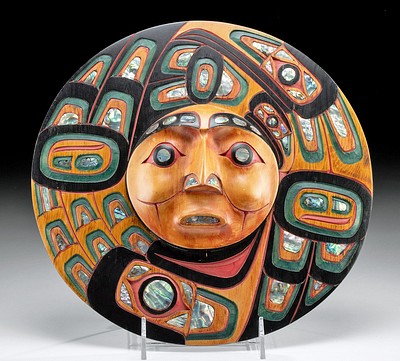18th C. Indian Mughal Sandstone Engaged Column w/ Lions
Lot 80
About Seller
Artemis Gallery
686 S Taylor Ave, Ste 106
Louisville, CO 80027
United States
Selling antiquities, ancient and ethnographic art online since 1993, Artemis Gallery specializes in Classical Antiquities (Egyptian, Greek, Roman, Near Eastern), Asian, Pre-Columbian, African / Tribal / Oceanographic art. Our extensive inventory includes pottery, stone, metal, wood, glass and textil...Read more
Categories
Estimate:
$4,000 - $6,000
Absentee vs Live bid
Two ways to bid:
- Leave a max absentee bid and the platform will bid on your behalf up to your maximum bid during the live auction.
- Bid live during the auction and your bids will be submitted real-time to the auctioneer.
Bid Increments
| Price | Bid Increment |
|---|---|
| $0 | $25 |
| $300 | $50 |
| $1,000 | $100 |
| $2,000 | $250 |
| $5,000 | $500 |
| $10,000 | $1,000 |
| $20,000 | $2,500 |
| $50,000 | $5,000 |
| $100,000 | $10,000 |
| $200,000 | $20,000 |
About Auction
By Artemis Gallery
Dec 7, 2023
Set Reminder
2023-12-07 10:00:00
2023-12-07 10:00:00
America/New_York
Bidsquare
Bidsquare : Fine Antiquities, Ancient & Pre-Columbian Art
https://www.bidsquare.com/auctions/artemis-gallery/fine-antiquities-ancient-pre-columbian-art-14361
Classical antiquities, ancient, and ethnographic art from cultures encompassing the globe. Egyptian, Greek, Roman, Etruscan, Near Eastern, Asian, Pre-Columbian, Native American, African / Tribal, Oceanic, Spanish Colonial, Fine / Visual Arts, so much more! Artemis Gallery info@artemisgallery.com
Classical antiquities, ancient, and ethnographic art from cultures encompassing the globe. Egyptian, Greek, Roman, Etruscan, Near Eastern, Asian, Pre-Columbian, Native American, African / Tribal, Oceanic, Spanish Colonial, Fine / Visual Arts, so much more! Artemis Gallery info@artemisgallery.com
- Lot Description
South Asia, India, Mughal Empire, ca. 18th to 19th century CE. A monumental and marvelous engaged column, hand-carved from sandstone in 4 parts, including a flared base, a tiered pedestal, a smooth shaft, and an intricate capital of 2 lion's heads amongst acanthus leaves and flowers. The head of each beast projects forward, peering downward at the viewer as though emerging from the leafy foliage of the jungle. The Mughals had a great predilection for Indian fauna, and lions were especially significant as they symbolized power, as well as the superiority of the Mughal Empire. Size of capital : 19" L x 18" W x 14" H (48.3 cm x 45.7 cm x 35.6 cm); of pedestal: 15" L x 13" W x 9" H (38.1 cm x 33 cm x 22.9 cm); of base 12.5" L x 13.5" W x 6" H (31.8 cm x 34.3 cm x 15.2 cm); of shaft: 10" L x 8" W x 37" H (25.4 cm x 20.3 cm x 94 cm); of all together: 19" L x 18" W x 66" H (48.3 cm x 45.7 cm x 167.6 cm)
Under Mughal rule, the lion had become royal game in so far as only the emperor and his favored relatives, courtiers, or guests would be permitted to hunt it. It was also believed that killing a lion was a lucky omen. Conversely, if the lion escaped during the hunt, trouble would befall the Empire.
Provenance: private Constance McCormick Fearing estate, Montecito, California, USA, acquired before 2004
All items legal to buy/sell under U.S. Statute covering cultural patrimony Code 2600, CHAPTER 14, and are guaranteed to be as described or your money back.
A Certificate of Authenticity will accompany all winning bids.
We ship worldwide and handle all shipping in-house for your convenience.
#180975Capital, shaft, base, and pedestal can be taken apart as 4 separate pieces. Expected chips, nicks, and abarasions as shown, but otherwise each piece is intact and in very good condition. Great remaining sculpted detail.Condition
- Shipping Info
-
All shipping is handled in-house for your convenience. Your invoice from Artemis Gallery will include shipping calculation instructions. If in doubt, please inquire BEFORE bidding for estimated shipping costs for individual items.
-
- Buyer's Premium



 EUR
EUR CAD
CAD AUD
AUD GBP
GBP MXN
MXN HKD
HKD CNY
CNY MYR
MYR SEK
SEK SGD
SGD CHF
CHF THB
THB















